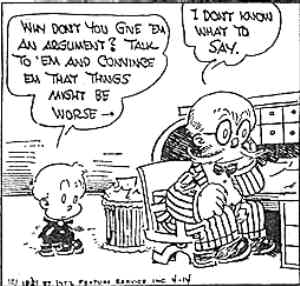| … successful one that could be relied on to appear six times per week. Back then, there wasn't as much variety in them as later came to be. One or two, such as Toonerville Folks, concerned young kids (among other topics), but the first comic strip about adolescence, Harold Teen, wasn't yet even a gleam in creator Carl Ed's eye.
But starting December 29, 1913, there was a strip that could, from appearances, have starred a young child, an adolescent, or a functioning adult. Jerry Flannigan, the title character of cartoonist Walter C. Hoban's Jerry on the Job, was about the size of a 5-year-old who was small for his age, and proportioned like an infant (larger head as compared with the rest of his body) only more so — Jerry was only two heads tall; i.e., the remainder of him, all put together, was about as big as his head. Even a Smurf is closer to a naturally-proportioned adult. And yet, he held down a steady job — a succession of them, in fact — and seemed to be making his own way in the world, independent of adult supervision.
At first, Jerry was an office boy, a position Hoban himself had held not long before. (Like many other cartoonists, including such notables as Rube Goldberg, he'd gotten much of his art training from office work in a newspaper's art department.) But after a year or two, he began moving from job to job. He was a retail clerk, a messenger boy, even a prize fighter (at his size!) and other things before Hoban went off to fight World War I, and the strip went on hiatus. When it returned, Jerry was working at a railroad station under the supervision of Mr. Givney, the station's manager. His job included just about everything that went into making a railroad station function — selling tickets, sweeping floors, toting baggage, running little errands for the boss, etc.
Sources of humor included the eccentrics who hung around the station, Mr. Givney's peevishness, and Jerry's own ineptitude. Also, Hoban pioneered in the use of humorous signs posted here and there in the background, a motif also seen in Smokey Stover, Mad magazine and elsewhere. And practically everyone commenting on the strip has praised Hoban for putting his characters through spectacular "takes", that is, exaggerated physical responses to surprising or disconcerting events. He specialized in what some call the "flip take", which left the character undergoing it (usually Givney) as flat on the ground as Charlie Brown after trying to kick Lucy's football.
Jerry on the Job debuted in The New York Journal. This was a Hearst paper, which meant Hoban's strip was available to other Hearst papers through the company's International Feature Service. When the organization launched King Features Syndicate, Jerry was one of its initial offerings.
And when animated cartoons about King Features characters, such as The Katzenjammer Kids and Happy Hooligan, started being produced, Jerry was there too. His first, titled Jerry Ships a Circus, produced by John Bray (Quacky Doodles) and directed by Gregory La Cava (Judge Rummy) and Vernon Stallings (Col. Heeza Liar), was released November 13, 1916. About 30 cartoon shorts about Jerry had come out by 1920, when Hearst left the animation business.
In 1921, a Sunday page about Jerry was launched; but later in the '20s it was demoted to a mere topper for another Hoban feature, Rainbow Duffy. The daily strip ended in 1931, leaving nothing but the topper; and in '32, even that was dropped.
But Jerry wasn't finished. In the late '30s, he became an advertising toon, shilling for Post Grape Nuts in comics-formatted ads that ran in newspaper funnies sections. In 1938, he even appeared on the cereal box. In this incarnation, he wasn't drawn by Hoban (who died in 1939), but by the cartoonist's former assistant, Bob Naylor (whose other credits include Barney Baxter). Naylor also drew characters much like Jerry in both form and function, as humorous fillers for DC Comics during the early 1940s.
Starting October 21, 1946, Naylor spearheaded a revival of Jerry on the Job as a syndicated comic for King Features. But while his artwork looked a lot like Hoban's, Naylor never managed to capture the sometimes zany humor of the original. The strip folded for good in 1949.
— DDM
BACK to Don Markstein's Toonopedia™ Home Page
Today in Toons: Every day's an anniversary!
| |
Purchase Comic Strip Reprints Online
|
